Discover 11 hidden attractions, cool sights, and unusual things to do in Cohoes (United States). Don't miss out on these must-see attractions: Cohoes Falls, Peebles Island State Park, and Cohoes Music Hall. Also, be sure to include Cohoes City Hall in your itinerary.
Below, you can find the list of the most amazing places you should visit in Cohoes (New York).
Table of Contents
Cohoes Falls
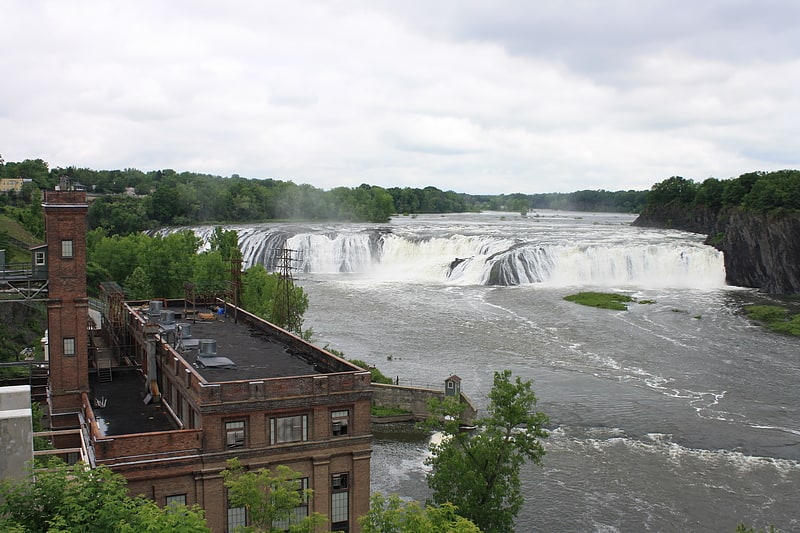
Waterfall in New York State. Cohoes Falls is a waterfall on the Mohawk River shared by the city of Cohoes and the town of Waterford, New York. Discovered by the indigenous people, the falls are called Ga-ha-oose or Ga-ho'n'-yoos by the Mohawks, which means "High Falls." Cohoes historian Arthur Masten wrote in his 1880 history that the phrase might mean "Potholes in the River," referring to the potholes that appear in the riverbed when it is dry. However, Kanatsiohareke and Canajoharie, NY bear names with reference to this meaning in Kanien'ké:ha. In the oral and written tradition of the Haudenosaunee, the Cohoes Falls are the site where The Great Peacemaker, performed a feat of supernatural strength, convincing the Mohawk people to become the founders of the Iroquois League of Nations or Confederacy. Some historians believe the Mohawks launched the Confederacy as early as 1142 CE, though other experts report dates ranging from 1450–1650.
Celebrated by 18th-century travelers in letters and journals, the Cohoes Falls, also called The Great Falls of the Mohawk, were regarded as the second-most beautiful cataract in New York State after Niagara. In 1804, the national poet of Ireland, Thomas Moore, visited Cohoes and wrote a paean to the waterfall's beauty: "Lines Written at the Cohos, or Falls of the Mohawk River."
In 1831, town leaders built a dam across the Mohawk River to harness the power of the falls to fuel the turbines of the city's burgeoning textile industry. Over the next several decades, the predominant company, Harmony Mills, became the largest manufacturer of cotton in the United States, thanks to its control of local water rights. When all the mills closed in the wake of the Great Depression, city leaders leased the flow rights to a series of power companies, including Niagara Mohawk and Orion Power.
The Erie Canal was planned to overcome the navigational barrier of the Cohoes Falls. The original "Clinton's Ditch", the Erie Canal of 1825, was built through the city of Cohoes. The later Enlarged Canal was realigned, yet still went through the City of Cohoes. The Barge Canal, which opened in 1918, bypasses Cohoes and runs through the Village of Waterford via the Waterford Flight of Locks.
The Cohoes Falls is 90 feet high and 1,000 feet wide. Its flow is greatest in springtime, sometimes running at 90,000 cubic feet of water per second. The flow varies with seasonal variation of Mohawk River flow as well as with diversions for the Barge Canal locks, power generation, and the Cohoes water supply. During the summer, the falls are virtually dry, revealing shale rock formations that have their own distinctive beauty. The 87-year average flow of the Mohawk River at Cohoes is 34,638 cubic feet per second, but this includes water diverted to the power plant and Erie Canal locks.[1]
Address: 231-341 North Mohawk Street, Cohoes
Peebles Island State Park
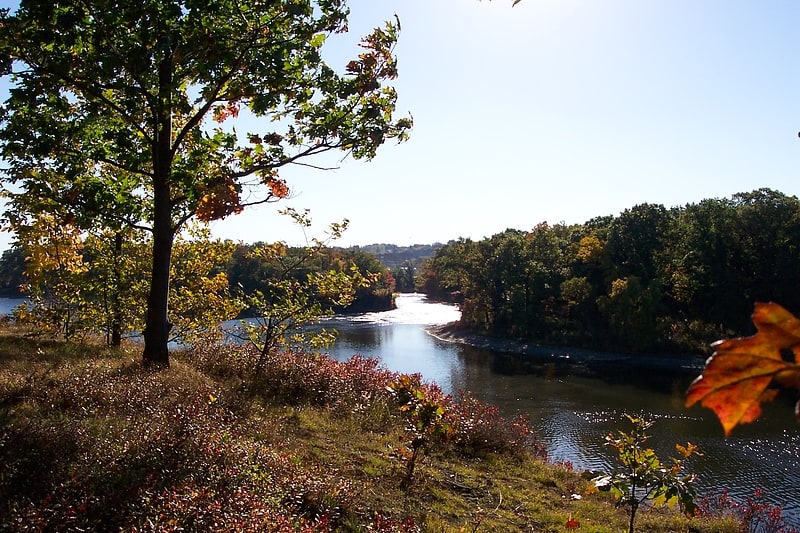
State park in Saratoga County, New York. Peebles Island State Park is a 190-acre state park located at the confluence of the Mohawk and Hudson rivers in New York. A majority of the park is located in Saratoga County, with a smaller portion located in Albany County.[2]
Address: Delaware Ave, Cohoes
Cohoes Music Hall
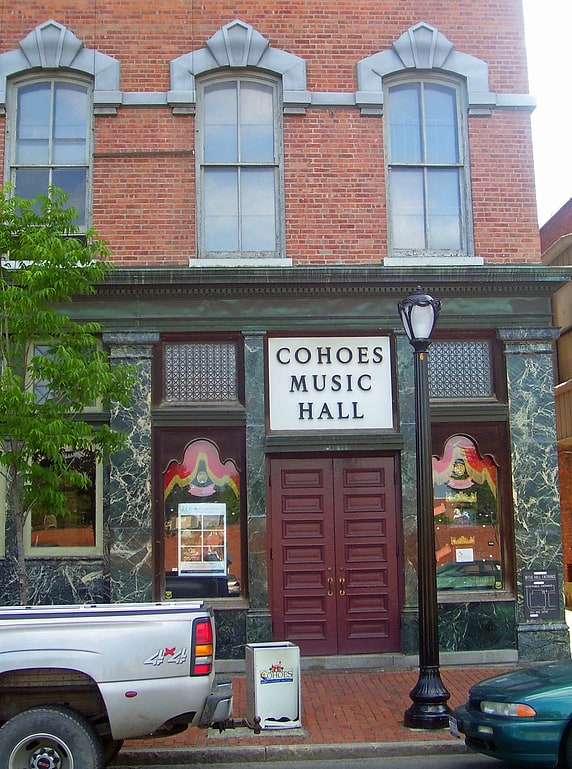
Music hall in Cohoes, New York. Cohoes Music Hall is a vintage music hall located at 58 Remsen Street in Cohoes, New York, United States. It is a four-story brick building in the Second Empire architectural style. Built in 1874, it is considered the best example of that style in the city, with an unusually decorative front facade.[3]
Address: 58 Remsen St, 12047-2623 Cohoes
Cohoes City Hall
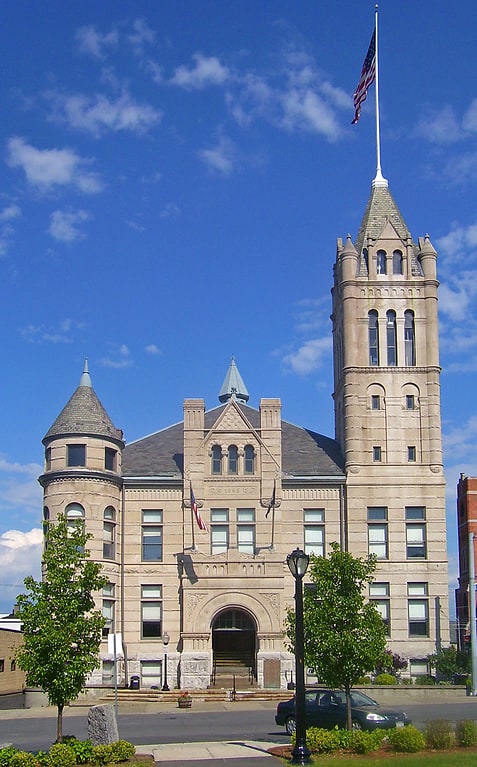
City or town hall in Cohoes, New York. Cohoes City Hall is located at 97 Mohawk Street in the city of Cohoes, New York, United States. It combines elements of the Chateauesque and Romanesque Revival architectural styles popular when it was built in 1896. J.C. Fuller, the Kansas state architect at the time, was chosen for his experience in designing public buildings.
It is a contributing property to the Downtown Cohoes Historic District, listed on the National Register of Historic Places in 1984. It is symbolic of the city within the Capital District, and is used in Cohoes' current seal. The city government and police department are based in it.
It is faced in smooth ashlar limestone with alternating bands of rough stone. Its Chateauesque aspects, such as the stonework, irregular silhouette, conical-roofed towers, wall dormers and ornamental cresting with finials. The main entrance's rounded arch with support from thick, foliated columns is a distinct Romanesque touch, however.
In recent years its age has made it a difficult building to keep warm in the wintertime. Even with the windows closed, City Hall has been drafty. The city installed Cellular Shades, and later window insulating panels, to keep it warm.[4]
Address: Cohoes, 97 Mohawk St. Cohoes, NY, United States
Downtown Cohoes Historic District
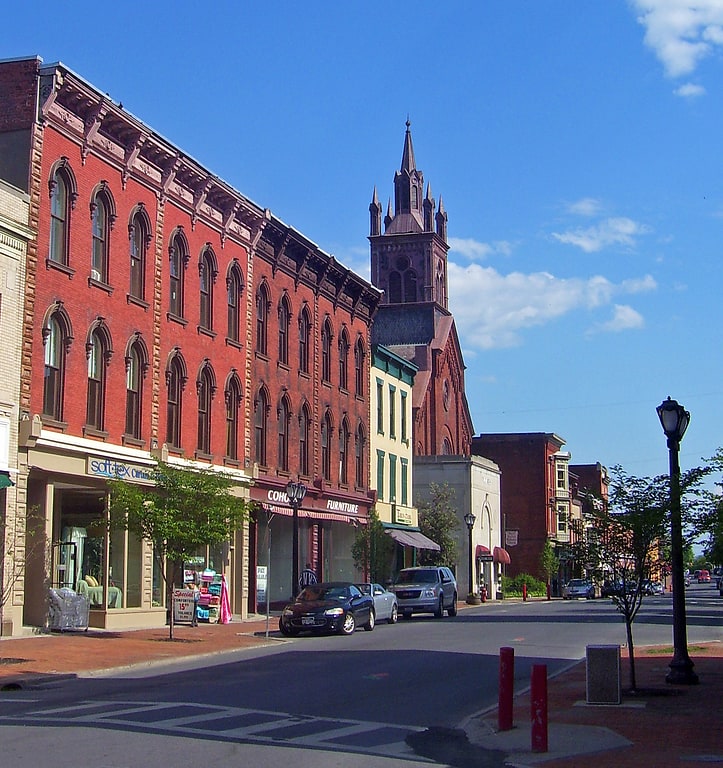
The Downtown Cohoes Historic District takes up 35 acres of the city of Cohoes, New York, United States. Many of the 165 contributing properties date from the 1820-1930 period when the Erie Canal and Harmony Mills were the mainstay of the city's economy. It was recognized as a historic district and added to the National Register of Historic Places in 1984. After years of neglect and decline, it has recently started to see an upswing in business activity due to its historic character and the city's efforts to protect it.
It is a roughly triangular area encompassing most of the city's business district, along the axes of Ontario and Remsen streets. Most of its buildings are contributing properties, with only a few late 20th-century intrusions; most of those are residential or commercial and in-use but they also include several churches, factories, a train station and the city hall. They range in architectural styles from Federal to Art Moderne.
One building within the district, Cohoes Music Hall, was listed on the National Register before the creation of the district. Another National Register listing, the Silliman Memorial Presbyterian Church, was demolished in 1998. A similar fate befell a church building designed by Richard Upjohn after it burned in 1894, but its rectory survives.[5]
Harmony Mills
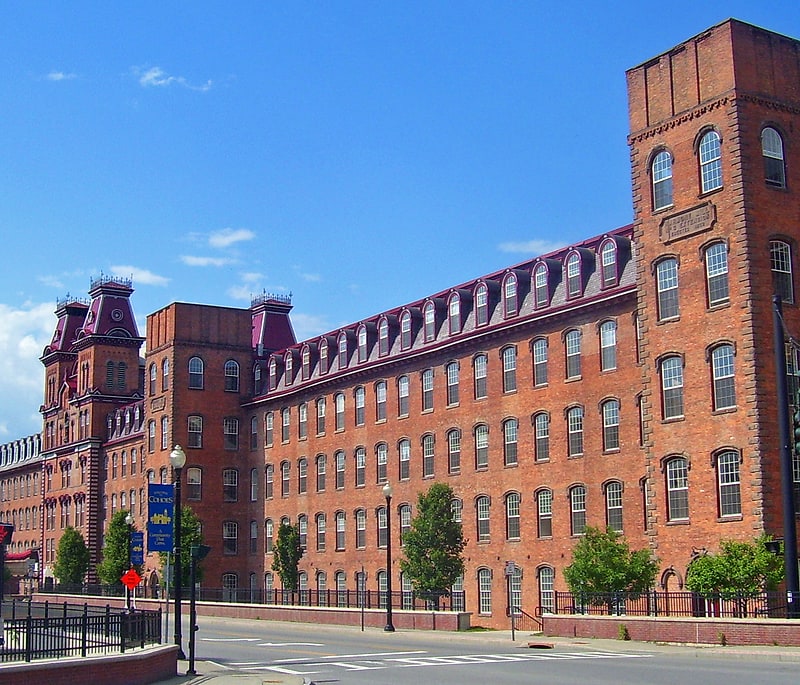
Apartment building in Cohoes, New York. Harmony Mills, in Cohoes, New York, United States, is an industrial district that is bordered by the Mohawk River and the tracks of the former Troy and Schenectady Railroad. It was listed as Harmony Mills Historic District on the National Register of Historic Places in 1978. A portion of the district encompassing the industrial buildings and some of the housing built for millworkers was declared a National Historic Landmark in 1999. The centerpiece building, Harmony Mill No. 3 was listed on the National Register of Historic Places in 1971.
It was the largest cotton mill complex in the world when it opened in 1872, and is one of the finest examples of a large-scale textile mill complex outside of New England.
The complex went into decline after its largest tenant, Barclay Home Products, went out of business in 1988. Mill 2 burned down in 1995. Mill 1 suffered devastating damage in a second fire in 1998.
Developer Uri Kaufman purchased the complex in 2000.
In 2005–2006, a portion of Mill 3 was renovated and turned into high-end residential lofts. The 96 loft apartments completed in this first phase were at 100% occupancy by July, 2006. A second phase containing 135 units was completed in 2010, adding a pool and spa and other luxury amenities. This phase—98% leased as of July, 2012—was called Harmony Mills Fallsview Luxury Apartments because of the views of the Cohoes Falls.
A third phase, restoring Mills 1 & 4 was commenced in early 2013. Mill 4 was completed in early December, 2013. 31 of its 33 loft apartments were pre-leased prior to receipt of the Certificate of Occupancy on December 6, 2013. In all, the Harmony Mills now contains 340 luxury loft apartments.
The revival of the Mills sparked a revival of the City of Cohoes. In the 2010 census, the City gained population for the first time since 1930. According to a study by the Center for Economic Growth, Cohoes was the fastest growing city in New York State in both 2015 and 2016. The project has been hailed as a prime example of how adaptive re-use of historic buildings can revitalize cities, while clearing urban blight in an environmentally friendly manner.
For his efforts in restoring the Harmony Mills, Uri Kaufman was awarded the New York State Preservation League Excellence Award. The Harmony Mills is featured on the Home Page of the New York State Historic Preservation Office Website, as a leading example of historic preservation development.[6]
Harmony Mill No. 3
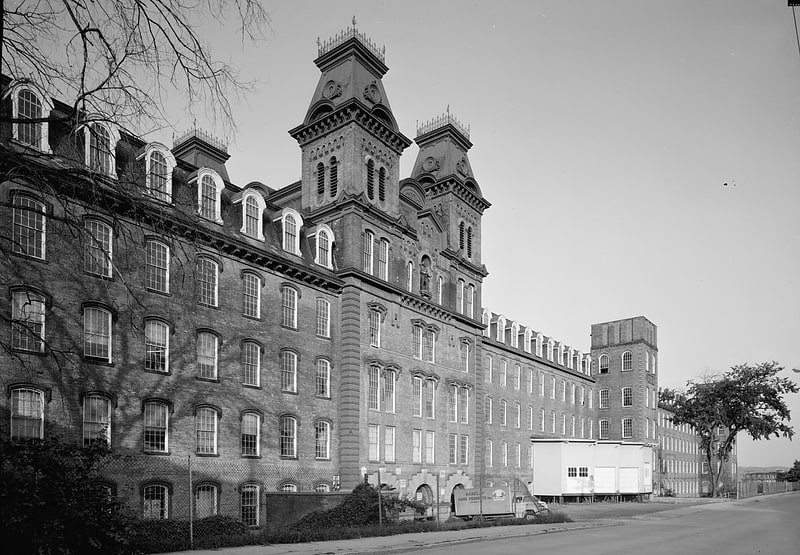
Harmony Mill No. 3, also known as the "Mastodon Mill", is a historic mill located at Cohoes in Albany County, New York. It was built in 1866–1868 and expanded 1871–1872. It is a four-story red brick structure on a stone foundation, with an additional story under the distinctive mansard roof. It features twin six story towers topped by mansard roofs and cast iron grillwork. It was known as the "Mastodon Mill" for the skeleton of a mastodon found while excavating the north section. It is the centerpiece of the Harmony Mills Historic District.
It was listed on the National Register of Historic Places in 1971.[7]
Address: 100 N. Mohawk St, Cohoes
J. Leonard Lackman House
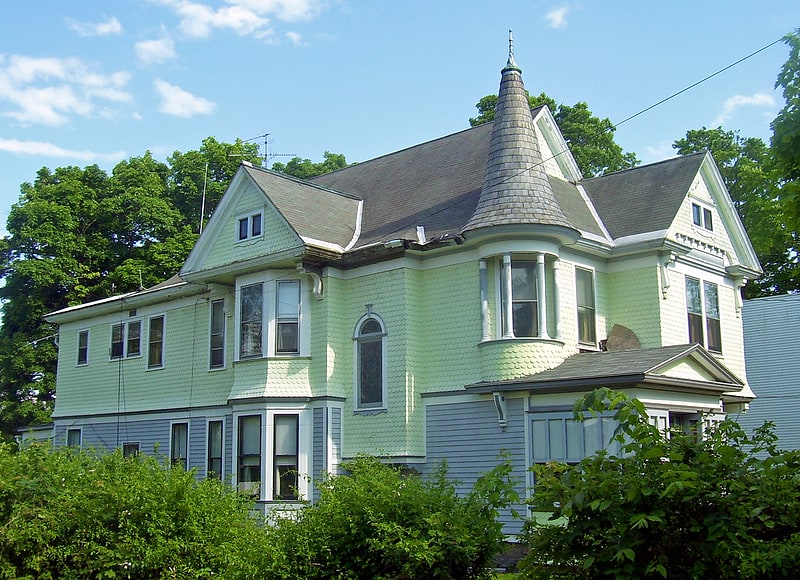
The J. Leonard Lackman House is located on Imperial Avenue in Cohoes, New York, United States. Lackman was a local gunsmith and locksmith. His descendants still own and reside in the house as of 2009.
It was built in the late 19th century in the then-popular Queen Anne architectural style. In 1998 it was added to the National Register of Historic Places.[8]
William J. Dickey House
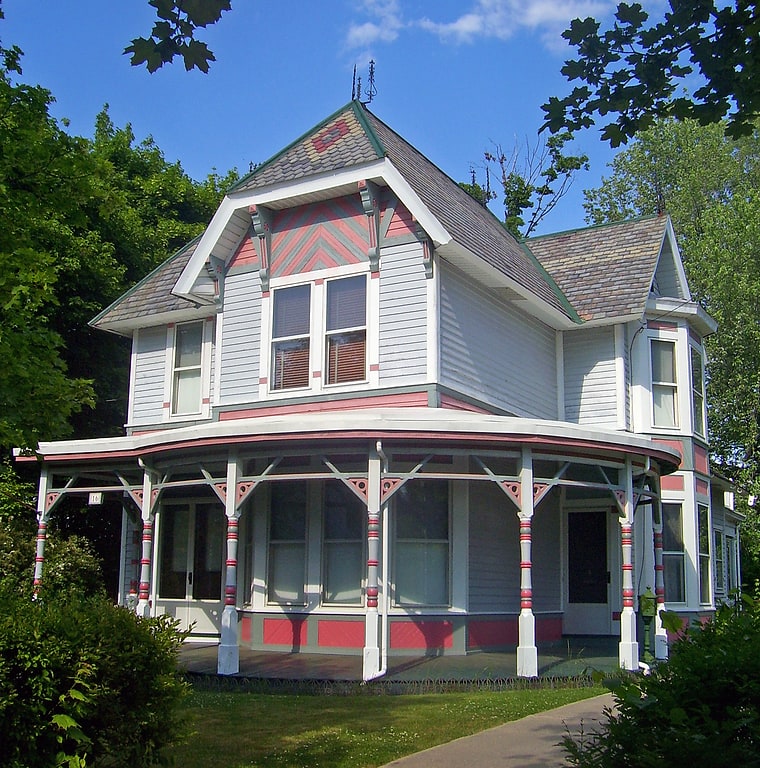
The William J. Dickey House is located on Imperial Avenue in Cohoes, New York, United States. It was built for Dickey, the superintendent of a local textile mill, in 1890, by an unknown architect.
It is a well-preserved example of local Queen Anne-style residential architecture. In 1998 it was added to the National Register of Historic Places.[9]
Olmstead Street Historic District
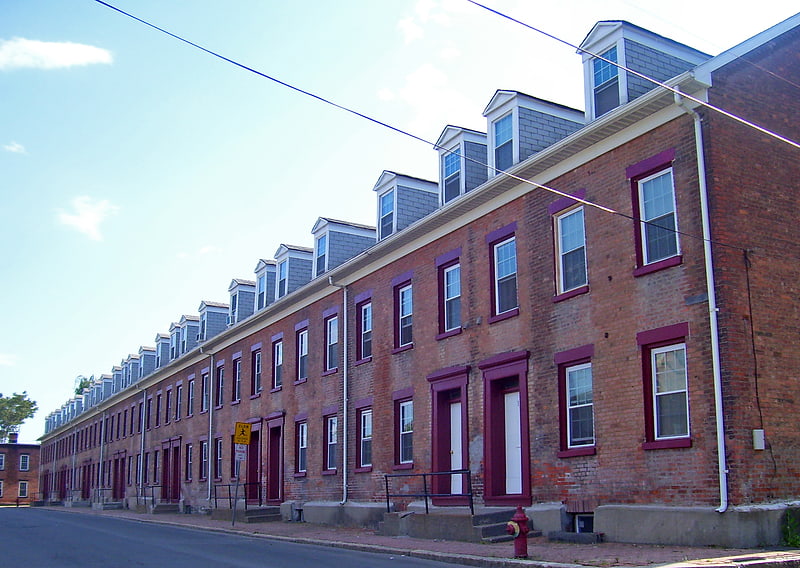
The Olmstead Street Historic District is located along two blocks of that street in Cohoes, New York, United States. It is a microcosm of the city's economy at its peak in the mid- to late 19th century, consisting of a former textile mill complex, a filled-in section of the original Erie Canal, and three long blocks of row houses built for the millworkers.
It was added to the National Register of Historic Places in 1973. Today the row houses still serve as affordable housing.[10]
Enlarged Erie Canal Historic District
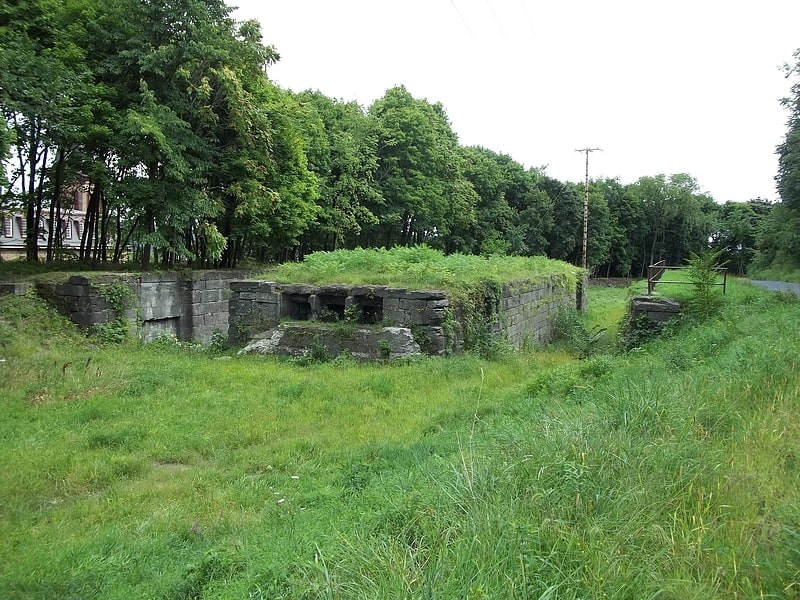
Enlarged Erie Canal Historic District is a national historic district located at Cohoes in Albany County, New York. It includes two contributing buildings and 10 contributing structures. It encompasses resources associated with the Enlarged Erie Canal, 1835–1862, Locks 9 through 18, and located within the City of Cohoes. The district includes five numbered units with each unit representing a cohesive grouping of resources highlighted by one or more extant canal locks. Each unit consists of at least one remaining lock and the associated elements including sections of towpath, berm walls, engineering features, and canal prism.
- Unit 1: Lock 9
- Unit 2: Lock 10
- Unit 3: Locks 14 and 15
- Unit 4: Lock 17
- Unit 5: Lock 18
It was listed on the National Register of Historic Places in 2004.[11]